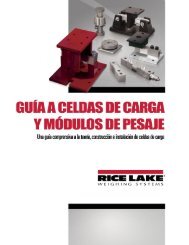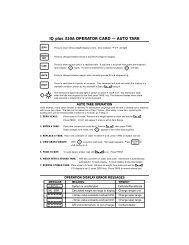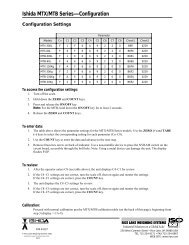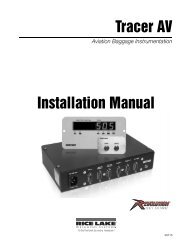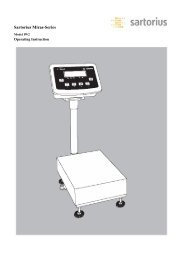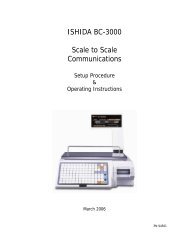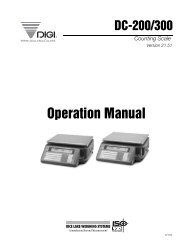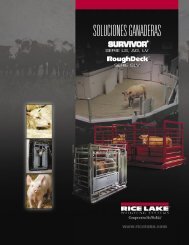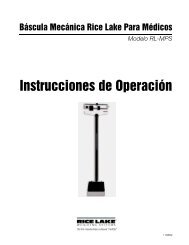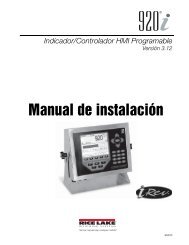English - Rice Lake Weighing Systems
English - Rice Lake Weighing Systems
English - Rice Lake Weighing Systems
Create successful ePaper yourself
Turn your PDF publications into a flip-book with our unique Google optimized e-Paper software.
A magazine and REFERENCE TOOL FOR THE WEIGHING INDUSTRY / Winter 2013 • issue 2 • vol. 9<br />
Rig It Right<br />
Four rules for riggers<br />
Cherries in Motion Tree to box in minutes<br />
Check the Pockets<br />
Before you buy a truck scale
This issue<br />
Editorial Staff<br />
We earn it.<br />
Our greatest asset and differentiator as a company is plain and simple:<br />
great customer service.<br />
Our people make it easier and more pleasant to do business with us. When customers<br />
call us, a friendly voice answers the phone—as quickly as possible. (Our goal is<br />
to answer every call on the first or second ring.)<br />
In the short article on page 16, “When load cells fly,” you will see an example of how<br />
far we will go to get our equipment in your hands when you need it.<br />
In these pages you also will read about our new <strong>Rice</strong> <strong>Lake</strong> company, Measurement<br />
<strong>Systems</strong> International (MSI) and their weighing equipment for crane operators and<br />
riggers. On page 14, “Check the Pockets,” Bill Murphy, our heavy capacity director,<br />
gives you a surefire way to compare truck scales before you buy. In all, we give you<br />
28 pages dedicated to weighing technology and interesting new application stories.<br />
We also give you our thanks for your business. Last year, 2012, was our best year<br />
ever. Looking forward, we see strengthening relationships with all of our customers<br />
in the new year.<br />
We will continue to earn your commitment to us.<br />
Melanie Al Faraj, Technical Writer<br />
Tamala Anderson, Designer<br />
Cheryl Aune, Literature Manager<br />
Matt Davis, Marketing Specialist<br />
Jessica de la Cruz, Writer<br />
Micah Fauske, Designer<br />
James Hanson, Web Development Specialist<br />
Melissa Hjelle, Marketing Specialist<br />
Megan Katcher, Marketing Coordinator<br />
Nicole King, Marketing Coordinator<br />
Rita Lenzen, Marketing Coordinator<br />
Katy Madden, Story Editor<br />
Kelly Musil, Catalog Manager<br />
Caleb Olson, Technical Writer, Reporter<br />
Carrie Popple, Technical Writer<br />
Pat Ranfranz, Marketing Director<br />
Hannah Rechsteiner, Designer<br />
Tina Slayton, Marketing Specialist<br />
Stacy White, Marketing Specialist<br />
Kristina Zengaffinen, Senior Designer<br />
Sincerely,<br />
Steve M Parkman<br />
Chief Operating Officer<br />
Steve Parkman, Chief Operating Officer<br />
<strong>Rice</strong> <strong>Lake</strong> <strong>Weighing</strong> <strong>Systems</strong><br />
2 RICE LAKE MAGAZINE | www.ricelake.com
this issue<br />
RICE LAKE MAGAZINE • Winter 2013 • Issue 2 • Vol. 9<br />
Inside<br />
page 4 What’s New <strong>Rice</strong> <strong>Lake</strong> presents the latest weighing equipment and technology page 6<br />
Rig It Right Four Advantages of Using the MSI-7300 Dynamometer page 10 Cherries<br />
in Motion MotoWeigh® generates quick ROI for end-users page 14 Check the Pockets<br />
Comparing truck scales page 17 Coil Scale Ingenuity Steel manufacturer’s custom coil scale<br />
increases efficiency and safety, and reduces cost page 18 The Science of Silos<br />
6<br />
A look at SYCSA’s impressive Silo R & D center page 22 The Winner’s Circle The 920i®<br />
indicator/controller, SURVIVOR® OTR truck scale, and <strong>Rice</strong> <strong>Lake</strong> load cells page 25 A Cut Above<br />
<strong>Rice</strong> <strong>Lake</strong>’s MajorSlice commercial slicers take a lead role in delis page 26 <strong>Rice</strong> <strong>Lake</strong> Scales<br />
Help Break World Records Dependable, repeatable accuracy convinces judges<br />
10<br />
RICE LAKE MAGAZINE<br />
Online<br />
Go green. Access <strong>Rice</strong> <strong>Lake</strong> magazine online.<br />
You will enjoy the same great stories plus links to more<br />
information. Also, with electronic access, you can easily<br />
share articles with employees and customers.<br />
To Subscribe<br />
Go to ricelake.com/ricelakemagazine<br />
and complete the online form. It is that easy.<br />
If you have any questions, please email us at<br />
rlmagazine@ricelake.com.<br />
To unsubscribe call 715-234-9171, ext. 5139<br />
Find us on Facebook:<br />
facebook.com/<br />
ricelakeweighingsystems<br />
18<br />
An ISO 9001 registered company © 2013 <strong>Rice</strong> <strong>Lake</strong> <strong>Weighing</strong> <strong>Systems</strong><br />
www.ricelake.com | RICE LAKE MAGAZINE 3
WHAT’S NEW<br />
New weighing<br />
solutions<br />
New batchers and<br />
bulk-weighing fillers<br />
920i® FlexWeigh <strong>Systems</strong><br />
Check out new multi-ingredient batchers that batch up to four ingredients at dual speed,<br />
or eight at single speed. The 201 model Batch-to-Container sequentially fills ingredients into<br />
a container up to the scale target weight. The 202 model Batch-to-Hopper & Discharge<br />
sequentially fills ingredients up to the target weight; and then discharges into a vessel.<br />
Expanded line includes fillers designed for use with limited-capacity hoppers.<br />
For bulk shipping, the model 107 automatically fills and discharges<br />
a hopper up to target weight.<br />
For bulk receiving, the model 108 fills and dispenses a hopper<br />
until all product is received and accumulates the weight.<br />
Model 109 handles bulk shipping or receiving: switchable modes<br />
via operator key switch.<br />
Learn more at ricelake.com/920iflexweigh. ▪<br />
Load cell<br />
Wiring Guide App<br />
for your mobile devices<br />
Just announced, our popular<br />
Load Cell Wiring Guide is now<br />
available as a mobile application<br />
for smartphones, tablets and PCs.<br />
Verify the signal, excitation, and<br />
sense wire colors of almost every<br />
industrial load cell brand and<br />
model—at the touch of a button!<br />
The app will be available in early<br />
2013 from your device’s app store,<br />
but you can find it online right now<br />
at ricelake.com/wireapp. ▪<br />
4 RICE LAKE MAGAZINE | www.ricelake.com
WHAT’S NEW<br />
Measurement <strong>Systems</strong> International (MSI), a scale equipment<br />
manufacturer based in Seattle, WA, was acquired by <strong>Rice</strong> <strong>Lake</strong><br />
<strong>Weighing</strong> <strong>Systems</strong> this past April. MSI has been in business since<br />
1977. The MSI line of strain gauge and microprocessor technologies<br />
is sold throughout the world. It includes industrial electronic scales,<br />
tension dynamometers, load monitoring instrumentation,<br />
RF wireless data acquisition and signal processing<br />
systems. msiscales.com ▪<br />
NAW® stops gnawing<br />
EL147RP Plus Rodent<br />
Protection Cable<br />
The “plus” stands for an added<br />
chemical coating that tastes<br />
terrible to rodents. EL147RP Plus<br />
also sports a tinned-copper over<br />
braid for another layer of rodent<br />
and abrasion resistance.<br />
For heavy radio frequency use<br />
areas, EL147RP Plus also delivers<br />
superior EMI/RFI protection.<br />
ricelake.com/naw<br />
▪<br />
for conveyors, slides, and chutes<br />
Easy-to-install MotoWeigh® Tunnel Metal Detector<br />
Material handling and processing takes a safer course with tunnel<br />
metal detectors at critical points. This detection equipment is ideal for<br />
food, hygiene products, chemical, and pharmaceutical industries.<br />
It is available in sandblasted stainless steel or epoxy paint finish.<br />
Detects free and encapsulated ferrous, stainless steel,<br />
aluminum, copper, and brass contaminants and passes<br />
requirements for ISO 9000, HAACP, IFS, and BRC quality<br />
inspections—all while protecting machinery from foreign objects.<br />
The touch screen control panel displays maximum information<br />
with easy and fast operation. The 5.7" backlit screen is large enough<br />
to display parameter data and protocol contents in a legible<br />
format. The oscilloscope function makes signal waves<br />
visible by projecting them onto the display.<br />
▪<br />
www.ricelake.com | RICE LAKE MAGAZINE 5
ON LOCATION<br />
ITI’s belief is that people have<br />
a greatly increased chance of retention<br />
by “seeing, speaking, and doing”<br />
all at the same time.<br />
Four Advantages<br />
of Using the<br />
MSI-7300<br />
Dynamometer<br />
“Crane and rigging<br />
accidents can be tracked<br />
back to a collection of events<br />
all happening at the same<br />
time. Having the load and/or<br />
tension information in hand<br />
helps reduce the risk<br />
associated with load handling<br />
and lowers the opportunity<br />
for an accident.”<br />
Mike Parnell, president of Industrial<br />
Training International<br />
Over the past quarter-century, Industrial Training International<br />
(ITI) has been recognized by clients and competitors alike for<br />
having an innovative and pioneering attitude toward training,<br />
and for having raised the current levels of instruction for cranes, heavy equipment, and<br />
rigging. ITI’s belief is that people have a greatly increased chance of retention by “seeing,<br />
speaking, and doing” all at the same time.<br />
ITI is headquartered in Woodland, Washington, and Edmonton, Alberta. Their training<br />
centers are located in Woodland, Washington; Memphis, Tennessee; Anchorage, Alaska;<br />
and Edmonton, Alberta.<br />
Mike Parnell, president of ITI, says, “We use dynamometers for a host of reasons, but<br />
four applications can be especially helpful to the rigger and crane operator. I chose the<br />
Continued on page 8<br />
6 RICE LAKE MAGAZINE | www.ricelake.com
Industrial Training International (ITI) has<br />
used MSI dynamometers in basic-to-advanced<br />
rigging training courses for over 20 years to<br />
reinforce the principles of rigging.
on location<br />
The MSI-7300<br />
helps students<br />
Mike Parnell, president of Industrial<br />
Training International (ITI), has used<br />
MSI dynamometers in his basic-toadvanced<br />
rigging training courses for<br />
over 20 years. He states, “They’re the<br />
best tool for reinforcing the principles<br />
of rigging when it comes to confirming<br />
tensions involved in horizontal and<br />
vertical load handling.” Students use<br />
the MSI-7300 dynamometer in every<br />
training module, both as a safety<br />
device and as a tool for verifying the<br />
theory taught in class. “The MSI-7300<br />
is like a grading system for the students—<br />
it confirms the theory behind<br />
proper rigging.” Mike says he chose<br />
the MSI-7300 for its lightweight design,<br />
large display, RF remote-display<br />
capabilities, and industry-leading<br />
safety specifications.<br />
Kyle McKinney, regional sales director<br />
for MSI, recently attended ITI’s Master<br />
Rigger Course. Kyle reports, “There was a<br />
common theme during discussion with<br />
the instructors—they loved the MSI-<br />
8000 RF Remote Display with the 7300<br />
Dyna-Link 2. During the Mobile Crane<br />
Lifting module, the instructor placed the<br />
remote display in the crane cab. That<br />
allowed them to keep an eye on the<br />
load weight while also guiding students<br />
through their rigging exercises.”<br />
Rig it Right continued from page 6<br />
MSI-7300 for its lightweight design, large<br />
display, RF Remote Display capabilities,<br />
and industry-leading safety specifications.<br />
Mike Parnell observes, “Crane and rigging<br />
accidents can be tracked back to a<br />
collection of events all happening at the<br />
same time. Having an accurate and continual<br />
readout of sling loading or gross<br />
load is a huge help to the riggers and lift<br />
director. Having the load and/or tension<br />
information in hand helps reduce the<br />
risk associated with load handling and<br />
lowers the opportunity for an accident.”<br />
Chain Hoist Drifting<br />
During a chain hoist load-drifting activity,<br />
the tension readout can help prevent<br />
equipment overload, since the horizontal<br />
distance, the horizontal angle, and the<br />
elevation are constantly changing. The<br />
rigger calculates for the worst-case drifting<br />
position but uses the Dyna-Link to<br />
ensure that he and the crew stay within<br />
the intended parameters.<br />
Load Up-righting<br />
With the MSI-8000 RF Remote Display,<br />
a Dyna-Link is very useful in a load<br />
up-righting event. Using an overhead<br />
crane, riggers often have to stand a load<br />
up from a laydown position. By using<br />
a Dyna-Link from the crane hook, the<br />
tension will generally lessen as the rigger<br />
hoists and trolleys to accommodate the<br />
load tilt-up. By observing the tension<br />
Mike Parnell, president<br />
Industrial Training International (ITI)<br />
The rigger calculates for the worst-case<br />
drifting position, but uses the Dyna-Link 2<br />
to ensure that the crew stays within<br />
the parameters intended.<br />
8 RICE LAKE MAGAZINE | www.ricelake.com
on location<br />
as it lessens, the crew can align a stepblock<br />
in a timely manner. A step-block<br />
or large wooden timber is used to create<br />
a new tipping axis. This helps prevent<br />
load “flopping” when the center of gravity<br />
passes the tilt-up corner.<br />
Disassembly and Demolition<br />
A third valuable place to use a Dyna-Link<br />
is during disassembly or demolition work.<br />
If a rigging crew knows that a motor and<br />
gear box on a bolted and grouted base<br />
weighs 4,500 pounds, then the Dyna-Link<br />
can be placed between the crane hook and<br />
the load rigging to help prevent overload<br />
to the equipment. Sometimes the alignment<br />
rods or cement grout underneath<br />
the load’s base are not sufficiently separated<br />
from the base. In effect the base is<br />
still secured to the building’s floor. The<br />
Dyna-Link will provide a live tension<br />
readout to the rigging crew. If the value<br />
in tension exceeds the known weight, the<br />
crew will need to find ways to separate<br />
the base from its mounting location (by<br />
jack hammer, concrete saw, cutting torch,<br />
hydraulic spreader jack, or other means).<br />
The photo at left shows a Dyna-Link between<br />
the hoist hook and the rigging.<br />
Training and Demonstration<br />
A crane-hook-suspended Dyna-Link can<br />
be a helpful tool for training crane operators<br />
to be “smooth.” With the peak-hold<br />
function activated on the Dyna-Link, an<br />
operator can be signaled to lift a load,<br />
move it horizontally, and lower it to a preapproved<br />
landing point. It is not unusual<br />
for the dynamic weight to momentarily<br />
peak to a value of 10-50 percent above the<br />
known suspended weight. The peak-hold<br />
function maintains the highest captured<br />
reading on the dynamometer since it was<br />
last cleared. If the operator swings (boom<br />
crane) or travels (bridge crane) and stops<br />
abruptly, the dynamometer can register a<br />
very high peak value. It helps the trainer<br />
demonstrate to the operator the need to<br />
manage the crane speed, acceleration, and<br />
deceleration carefully. All of this type of<br />
dynamic handling needs to be well within<br />
the crane and rigging’s capacity, which<br />
is generally less than 25 percent of the<br />
allowable rating in its configuration. ▪<br />
The MSI-7300<br />
Dyna-Link 2<br />
digital tension<br />
dynamometer<br />
is a trusted tool<br />
Test engineers, crane operators,<br />
riggers, surveyors, and staging<br />
professionals who want to rig<br />
it right depend on MSI-7300.<br />
Through advanced technology of<br />
the new MSI ScaleCore TM , a highly<br />
integrated weight-processing unit<br />
with 24 bit A/D conversion, Dyna-<br />
Link 2 provides new and improved<br />
performance features.<br />
Long-range viewing is enhanced by<br />
a large five-digit, 1.22 inch (31 mm) LCD with<br />
resolution settings up to 5,000 divisions and precision<br />
accuracy over a wide range of capacities.<br />
Peak digital processing with low power consumption<br />
provides up to 200 hours of operation from<br />
standard flashlight batteries during typical use.<br />
MSI-7300<br />
Dyna-Link 2<br />
The MSI-8000 RF Remote Display interfaces with MSI <strong>Weighing</strong> <strong>Systems</strong> by<br />
incorporating the MSI ScaleCore weight-processing unit; the MSI-8000 RF<br />
Remote Display communicates with the MSI-7300 Dyna-Link 2 and the MSI-3460<br />
Challenger 3. The compact, handheld indicator provides remote scale control<br />
capabilities and a large five-digit, 1.25<br />
inch (32 mm) liquid crystal display.<br />
The user-friendly keypad includes<br />
Power, Zero, Tare, Print, and two<br />
configurable function keys.<br />
The MSI-8000 interfaces to peripheral<br />
devices including printers, PCs, and<br />
MSI-8000 RF Remote Display<br />
scoreboards, and is integrated via a<br />
combination RS-232 serial and charging<br />
port. Optimum digital processing<br />
with low power consumption provides up to 24 hours of continuous operation<br />
from an integrated lithium ion battery. Anticipated useful RF range is up to 100 feet<br />
for line-of-sight applications. ▪<br />
www.ricelake.com | RICE LAKE MAGAZINE 9
on location<br />
As differently sized boxes<br />
approach the scale, their bar codes<br />
are scanned to reference the correct<br />
over/under values stored in the 920i.<br />
10 RICE LAKE MAGAZINE | www.ricelake.com
“Before MotoWeigh, I had never seen a product<br />
so seamless, especially at the speeds we wanted<br />
to run—240 feet per minute.”<br />
Roger Lohrmeyer, programmer for LCE <strong>Systems</strong>, Inc.<br />
in motion<br />
MotoWeigh® generates quick ROI for end users<br />
By Caleb Olson<br />
Cherry season is chaos. Starting in May, California cherry farmers<br />
have six weeks to harvest, package, and ship their cherries before<br />
the warmth of summer sets in. With such a small window of time, any kink<br />
in the chain of events, from destructive weather to equipment malfunction, can<br />
prove to be catastrophic. Most farmers use a third party to pack and ship their<br />
product; however, Camera Brothers, located in Stockton, California, undertakes<br />
the entire process from growing and picking to packing and shipping.<br />
Patti Azpeitia, controller of Camera Brothers, decided her operation needed an<br />
efficiency boost. Looking at the numbers, she estimated approximately 10% of her<br />
crop was being given away in overweight boxes. On top of that, product traceability<br />
and new barcode regulations were coming into effect—requirements her current<br />
equipment could not meet. An upgrade was in order.<br />
LCE <strong>Systems</strong>, Inc. specializes in the produce industry and had a solution for Camera<br />
Brothers. An in-motion checkweigher could integrate into the existing process,<br />
but it would need to not only be reliable, but also fast enough to handle the cherry<br />
season’s demanding throughput. “Joe [Ehlers] and I were able to visit <strong>Rice</strong> <strong>Lake</strong><br />
and demo MotoWeigh,” explains Daniel Cannistraci. “We saw how <strong>Rice</strong> <strong>Lake</strong> operates<br />
and wanted to work with the highest quality product, so we chose MotoWeigh<br />
for the application.” Roger Lohrmeyer, who handles most of LCE’s programming,<br />
adds, “Counting scales are common, but in this environment, that scale needs to<br />
be able to make a change in a fraction of a second. Before MotoWeigh, I had never<br />
seen a product so seamless, especially at the speeds we wanted to run—240 feet<br />
per minute. The 920i® is easy to work with and we knew it could handle everything we<br />
would throw at it.”<br />
LCE developed a plan to install the MotoWeigh. Camera Brothers was already<br />
thinking about remodeling the cherry shed and consulted with LCE to ensure the<br />
new equipment would be incorporated in the new shed design. With academic<br />
experience in architecture, Joe Ehlers drew up layouts and provided dimensional<br />
drawings for the proposed setup. Previously lacking a product delivery system, the<br />
shed now has a horseshoe belt to route full cherry boxes to the MotoWeigh. Stacks<br />
of boxes on either end of the shed are replaced with an overhead box carousel, continuously<br />
passing operators so they are never farther than an arm’s length from the<br />
constantly needed supply. LCE’s unique experience allows them to provide much<br />
more than scale expertise. “Prior to LCE, we all worked together at a packing facility,”<br />
explains Roger. “We all have experience in the produce industry and the day-to-day<br />
operations, and can make those small changes that make a big difference.”<br />
Continued on page 12
on location<br />
Cherries in Motion continued from page 11<br />
With those small changes now in place,<br />
Camera Brothers is reaping big rewards.<br />
The shed’s system takes cherries from the<br />
tree to the box in a matter of minutes. First,<br />
cherries travel up an incline belt where<br />
cluster-cutters separate the stems. They<br />
then drop through gaps in the floor, with<br />
different gap widths determining cherry<br />
size. From there, cherries are sorted and<br />
sized one more time before going to the<br />
box fillers, after which filled boxes travel to<br />
the MotoWeigh. Once at the MotoWeigh,<br />
each box travels over the indexer, which<br />
spaces them out so only one box is on the<br />
scale at a time. A scanner reads the box’s<br />
barcode and sends that information to the<br />
920i, which calls preset over/under/accept<br />
values. If the box is over or under tolerance,<br />
the 920i activates a diverter, sending it to a<br />
reject line at a smooth 45-degree angle.<br />
If a box is within the “accept” range, it<br />
continues on its conveyor, and an inkjet<br />
printer sprays nontoxic ink on the box.<br />
This information includes the type of<br />
cherry, size grade, GTIN barcode, and<br />
even the company logo. All information<br />
adheres to the 2012 Product Traceability<br />
Initiative which provides traceability<br />
standards and is becoming required by<br />
an increasing number of retailers.<br />
The first day the MotoWeigh was in production,<br />
however, it created some confusion.<br />
More boxes were being rejected than<br />
previously expected. The reject line operator<br />
was running out of room to stack the<br />
boxes. Surely, something must be wrong<br />
with the MotoWeigh. Using a CW-90 to<br />
double-check box weights confirmed that<br />
the rejected boxes were indeed out of tolerance.<br />
MotoWeigh was doing its job perfectly,<br />
rejecting all boxes more than one<br />
pound overweight. Also unexpected was<br />
the amount of underweight boxes, which<br />
could result in high fines and potential<br />
cancelled orders. With MotoWeigh in<br />
place, overweight and underweight boxes<br />
are not being shipped, and LCE estimates<br />
that the customer will see a great return<br />
on investment.<br />
“MotoWeigh is an easy sell because people<br />
need it right now,” Daniel explains. “With<br />
increased emphasis on product traceability<br />
and GTIN barcodes, packaging facilities<br />
You shall not pass! MotoWeigh’s diverter sends overweight and underweight boxes to a reject line.<br />
are panicking. If they don’t meet these requirements,<br />
retailers won’t buy their product.<br />
Plus, there is the cost-saving benefit of<br />
the checkweigher itself; you throw that in<br />
and it’s a much easier sell. It seems like a lot<br />
of scale dealers are scared to touch motion<br />
weighing because it’s not traditional, but<br />
MotoWeigh is what the customer needs,<br />
so you have to adapt.”<br />
LCE’s specialty is becoming in-motion applications,<br />
but they pride themselves on<br />
customer service and giving the customer<br />
more than they expect. They set up complete<br />
networks of equipment that have<br />
been designed for specific packing applications.<br />
LCE started doing the front end,<br />
then worked their way to the back end<br />
with inkjet systems. Next, they are moving<br />
toward the middle with box filling, which<br />
would make LCE a complete one-stop<br />
shop, benefitting the customer by calling<br />
one number instead of trying to contact all<br />
the people who worked on different parts<br />
of the system.<br />
Emphasis on customer service provides<br />
a natural pairing for LCE and <strong>Rice</strong> <strong>Lake</strong><br />
<strong>Weighing</strong> <strong>Systems</strong>. Daniel remembers<br />
one of his first dealings with <strong>Rice</strong> <strong>Lake</strong>.<br />
“We needed a hanger for an old mechanical<br />
scale. The manufacturer wasn’t<br />
making the part anymore and couldn’t<br />
help us. We contacted <strong>Rice</strong> <strong>Lake</strong>, sent<br />
them the broken part, and had a custommade<br />
replacement part sent back to us.<br />
We won the client’s full-time service<br />
business because of that experience. <strong>Rice</strong><br />
<strong>Lake</strong> provides solutions when nobody<br />
else can.” ▪<br />
With MotoWeigh®<br />
in place, overweight<br />
and underweight boxes<br />
are not being shipped, and<br />
LCE estimates that the<br />
customer will see a great<br />
return on investment.<br />
MotoWeigh performs a vital final check before<br />
cherry boxes are shipped.<br />
12 RICE LAKE MAGAZINE | www.ricelake.com
Street Legal<br />
Legal for Trade weighing for delivery route trucks<br />
Add TradeRoute to delivery route trucks and skip the trip to a certified truck scale for Legal for Trade weight.<br />
Immediate, on-site billing for delivered or collected materials saves vehicle expense and driver time.<br />
What makes TradeRoute unique is that it operates solely from a parked position<br />
when hydraulics are used to engage the scale. The truck hydraulic<br />
system lifts the container off the truck frame into weigh mode.<br />
Within 3 to 5 seconds the driver can begin a weighing transaction.<br />
The 920i ® indicator/controller displays prompts to lead the driver<br />
through the transaction, and prints customized weigh ticket.<br />
Visit www.ricelake.com/traderoute to learn more about<br />
TradeRoute Legal for Trade onboard scale systems.<br />
800-472-6703<br />
www.ricelake.com<br />
m.ricelake.com
When you compare truck scales<br />
Make sure load cell pockets are integrated into weighbridge<br />
By bill murphy, HEAVY CAPACITY DIRECTOR<br />
Wide-flange structural<br />
beams for strength<br />
Pocket end plates are constructed<br />
out of ¾-inch steel<br />
Precision laser-cut dovetails<br />
Competitor’s pockets are<br />
welded to the ends of the scale<br />
modules and have a tendency<br />
to bend and flex putting<br />
stress on welds
TECH TALK<br />
You are not looking for loose change when you check the load<br />
cell pockets to compare truck scales. Instead, you’re looking at a possible<br />
major expense—the cost of downtime if the load cell pockets are welded or bolted<br />
on instead of incorporated into the overall weighbridge design.<br />
The ends of the scale modules are one of the highest stress areas of any truck scale<br />
because this is where the truck traffic enters and exits the scale platform. On many<br />
competitors’ weighbridge designs, boxes to house the load cells are welded or bolted<br />
to the ends of the scale modules and have a tendency to bend and flex excessively as<br />
truck traffic enters and exits the scale. Over a period of time, these boxes have been<br />
known to break welds, and in many cases, even break away from the main portion of<br />
the bridge, causing loss of use and premature failure of the bridge.<br />
One of the key advantages of the <strong>Rice</strong> <strong>Lake</strong> bridge design is its extraordinary strength.<br />
The <strong>Rice</strong> <strong>Lake</strong> OTR Weighbridge design is not only tied to the amount of steel we<br />
provide, but also the manner in which these individual components are fabricated<br />
and engineered into the weighbridge structure itself.<br />
The weighbridge for a typical <strong>Rice</strong> <strong>Lake</strong> Survivor OTR consists of a 5/16 -inch checkered<br />
steel deck top plate that is welded to the top of twelve 12-inch wide-flange beams<br />
that are positioned longitudinally to the traffic flow. The spacing on the beams is on<br />
approximate 11½-inch centers, which means that the distance between beam flanges<br />
is only about 7½ inches. This ensures that no matter where a truck axle or tire is<br />
positioned on the weighbridge, it is fully supported by the steel deck, and beams.<br />
The individual ends of the twelve beams are welded to the ¾-inch end plate weldments<br />
running the width of the module, which include a load cell pocket fabricated<br />
from ¾-inch steel plate on each side. Most competitive models use ½-inch or ⁵⁄₈-inch<br />
end plates. The twelve longitudinal beams surround the load cell pocket, integrating<br />
the pocket into the bridge structure itself, as shown in the illustration to the left. This<br />
adds extraordinary strength and integrity to a very critical area of the weighbridge.<br />
<strong>Rice</strong> <strong>Lake</strong> takes one more very important step to ensure the strongest bridge design<br />
possible. The ¾-inch steel load cell pocket plates have precision laser-cut dovetails<br />
that are inserted into the ¾-inch end plates by laser-cutting tabs on the ends of the<br />
¾-inch load cell pocket plates, and laser cutting square holes in ¾-inch end plates<br />
for the tabs to fit.<br />
<strong>Rice</strong> <strong>Lake</strong> assembles the steel components within the weighbridge, which allows us<br />
to provide our weighbridges to meet extraordinarily high volume traffic demands<br />
and heavier truck loads. It is these critical design criteria that make the <strong>Rice</strong> <strong>Lake</strong><br />
OTR series a truly “generational scale.”<br />
From an engineering standpoint, the wide-flange structural beam is one of the<br />
strongest structural steel shapes available. The beam is much stronger than steel tubing,<br />
channels, bent steel plate, or many other types of steel components. Steel as an<br />
element is designed to bend when loaded, and return to its original shape when<br />
unloaded. If steel components are improperly chosen or sized, or are loaded beyond<br />
their original design characteristics for the application, fatigue or stretching of the<br />
steel will occur, affecting the accuracy, performance, and life span of the scale.<br />
Many competitive weighbridges use bent steel plate, junior beams, tubing or materials<br />
that are too light or improperly designed for the loads, resulting in eventual steel<br />
fatigue and a costly premature failure of the weighbridge.<br />
Another one of the best judges of a steel weighbridge’s ability to withstand heavy and<br />
consistent loads is the structural steel content. At <strong>Rice</strong> <strong>Lake</strong> <strong>Weighing</strong> <strong>Systems</strong> we<br />
make the heaviest and “Toughest Truck Scales on Earth.” A typical OTR Low Profile<br />
70 foot by 11 foot steel deck truck scale has a steel content of nearly 33,000 pounds—<br />
often several thousand pounds more than comparable products. ▪<br />
www.ricelake.com | RICE LAKE MAGAZINE 15
One recent, perfect Saturday afternoon, Chris Olsen, service<br />
manager, was mowing his lawn when his cell phone vibrated.<br />
A <strong>Rice</strong> <strong>Lake</strong> distributor on the East Coast needed<br />
a 750 lb load cell—tomorrow.<br />
The end user, a multibillion-dollar meat-processing company, had shut down a line<br />
to move equipment and accidently pulled the cable out of a load cell. They wanted the<br />
distributor to send out a technician to splice it. They had to be rolling in time for Monday’s<br />
early shift. But splicing the cable would not work. They needed a new load cell.<br />
Chris checked inventory and saw that <strong>Rice</strong> <strong>Lake</strong> had the load cell in stock. FedEx and<br />
UPS had no flights available Saturday night, but UPS could pick it up Sunday morning and<br />
deliver it to the distributor by 7:30 Sunday evening. Chris drove to the plant, flipped on the<br />
lights, located the load cell, and packed it up.<br />
On Sunday morning, Chris was waiting at the plant when the UPS truck drove<br />
into the lot. He handed over the load cell and went home to finish mowing his lawn.<br />
The email received from the distributor Sunday night declares:<br />
“Awesome job, Chris! Load cell arrived at 7:40 p.m.<br />
Going now to complete the job. No other scale company on earth<br />
would or could do what you people do. Thanks a bunch!”<br />
End of story.<br />
800-472-6703<br />
www.ricelake.com<br />
m.ricelake.com
ON LOCATION<br />
Coil Scale Ingenuity<br />
Steel manufacturer’s custom coil scale increases efficiency and safety,<br />
and reduces costly repairs and downtime<br />
Regardless of the industry, having the right tool for the right job is essential. An Illinois<br />
steel company discovered this when they tried to adapt a floor scale to weigh 60,000-pound<br />
coils. Constant breakdowns required emergency repair and regular load cell replacement,<br />
which caused costly work stoppages. Even when the scale was functional, it was a production<br />
bottleneck. The number of coils finished per day has an inverse correlation with the<br />
time taken to weigh the coil—as the time decreases, the quantity of coils increases and<br />
vice versa.<br />
One day, both the floor scale and the plant manager reached their breaking point. The<br />
manager called Kurt Hebenstreit at Champion Scale to ask for a long-term solution. The St.<br />
Louis scale shop visited the facility and assessed the challenge. Currently, a crane was lifting<br />
the coil onto the scale, which gave Kurt an idea. If he could automate the transport of coils<br />
across the scale, it would drastically increase efficiency. The scale would need to be rugged<br />
enough to handle the heavy coils and user-friendly to streamline the weighing process.<br />
What Kurt needed was a miniature railroad scale built flush with the production floor,<br />
and a corresponding miniature railroad car to carry the coil as it crossed the scale. This<br />
option would reduce scale damage; forklifts could safely drive<br />
over the scale instead of trying to navigate around an above<br />
ground option. Safety would also be increased by reducing tripping<br />
hazards. The only problem was such a scale didn’t exist. It<br />
would need to be custom built, and Kurt needed a company to<br />
work with him cost effectively on the design.<br />
He called <strong>Rice</strong> <strong>Lake</strong>.<br />
Kurt worked with a technical sales engineer who quickly<br />
provided a quote and drawings of a modified RoughDeck®<br />
floor scale. The plan was approved by the end-user, who was<br />
eager to reap the rewards of updated technology built to suit<br />
his unique requirements.<br />
Five years later, the RoughDeck CS is performing better than<br />
expected. With only routine maintenance, the work stoppages<br />
due to emergency repairs have been eliminated. In fact,<br />
the scale is still operating on its original load cells, which are<br />
mounted outside of the rail to reduce the strain of scale movement<br />
as the coil car crosses.<br />
The time to produce a coil has been reduced from an estimated<br />
25 minutes to 15 minutes due to the automated coil transportation.<br />
Instead of using a crane, now when a coil is ready to be<br />
weighed, the operator simply presses a button to lower it onto<br />
the coil car. The car moves across the RoughDeck CS, stopping<br />
for a quick weighment before continuing on its tracks to a holding<br />
area. The car then returns to its home base beneath the next<br />
coil, which is now ready to be wound.<br />
The increase in production and reduction of repair has helped<br />
the scale pay for itself. Having the right scale for the right job is<br />
integral—even if the scale hasn’t been invented yet.<br />
▪<br />
What Kurt needed was a<br />
miniature railroad scale built<br />
flush with the production<br />
floor, and to fit with the<br />
existing miniature railroad<br />
car to carry the coil as it<br />
crossed the scale.<br />
Once this 60,000-pound steel coil is wound, the railroad car lifts it off the cylinder<br />
and travels across the RoughDeck CS. All aboard!<br />
www.ricelake.com | RICE LAKE MAGAZINE 17
ON LOCATION<br />
THE SCIENCE OF<br />
SYCSA’s impressive R & D center has a complete small-scale plant to test materials and develop<br />
customized flow technology, including bins, hoppers with sensors to detect wall force,<br />
conveyance systems, valves, air pressure and vacuum technology, filling, mixing, and<br />
batching equipment, and silos mounted on <strong>Rice</strong> <strong>Lake</strong> RL9000 load cells. It is probably<br />
the first and only development center of this caliber in Latin America.<br />
Simply put, a silo is a structure for storing bulk material. Silo systems, though, can be anything but simple.<br />
The complicated part is to move the material stored in the silo in a smooth and controlled flow.<br />
Silos y Camioness (SYCSA), Pachuca, Mexico, has been building silos for 44 years. They began by<br />
fabricating small silos for transporting cement by truck, and tower silos for storing cement<br />
and additives for batching plants. In time, the need for transporting and storing larger<br />
quantities of cement grew. Customers also needed silos equipped with electronic<br />
weighing systems, digital displays, and printers to keep a more accurate inventory<br />
weight. In addition, SYCSA was finding new customers with different materials,<br />
including dry chemicals to add color to plastics; foods such as flour, corn, and<br />
sugar; and recycled materials such as shredded plastic and crushed glass.<br />
As processes changed and customers began to demand greater ease of operation,<br />
SYCSA’s expertise evolved to more sophisticated material handling,<br />
such as dosing in small quantities and formulating and processing<br />
material particles of different sizes, shapes, and characteristics that tend<br />
to segregate or stick together.<br />
In 1993, automation brought new tools and skills, and SYCSA<br />
began designing and manufacturing complete silo<br />
systems including components, piping, valves,<br />
air pressure, and vacuum technology to<br />
move materials from silos, bins, and<br />
hoppers through the entire batching<br />
and processing sequence. SYCSA’s<br />
Continued on page 20<br />
18 RICE LAKE MAGAZINE | www.ricelake.com
SILOS<br />
The RL9000TWM is a stainless steel, low profile,<br />
all-in-one weigh module that is very easy to install, and its<br />
robust design ensures many years of trouble-free service.<br />
The RL35023 is an alloy steel single-ended shear beam load cell<br />
design that allows it to be used in many applications from floor scales<br />
to bins, silos, and hoppers.<br />
Ratholes and bridges<br />
Two of the most common flow problems in silos are no-flow and erratic flow. No-flow can be caused by ratholing and bridging.<br />
Ratholing occurs when the material moves through the central part of the silo to the outlet while the remaining material sticks to the<br />
walls. If the material being handled has a sufficient cohesive strength, the stagnant material outside the channel will not flow through<br />
it. Once the rathole is emptied, there is no flow from the silo.<br />
Erratic flow occurs when the material in the silo flows intermittently and<br />
forms a bridge over the opening. The bridge collapses when the material<br />
above reaches a critical stress level and falls within the silo. Flow then<br />
continues until the next bridge forms.<br />
The potential for ratholing and bridging depends on several factors,<br />
including humidity, temperature, storage time, and the size, shape, and<br />
weight of the material, whether flakes, granules, or pellets. Caked material<br />
can often be dislodged by vibrating the silo or using an air cannon.<br />
If those methods are not successful, removing material adhering to<br />
the walls of a large silo is expensive.<br />
Rathole<br />
Bridge
ON LOCATION<br />
The Science of Silos continued from page 18<br />
experience grew as they worked with each type of material, culminating in a research and<br />
development center where the work team of SYCSA’s bulk material laboratory believes all<br />
flow problems can be solved through improvements in design. The laboratory manager<br />
observes, “It is very expensive to correct flow problems at the site. At the research and<br />
development center we can attack the problem much more cheaply.”<br />
SYCSA’s impressive R & D center has a complete small-scale plant to test materials and<br />
develop customized flow technology, including bins, hoppers with sensors to detect wall<br />
force, conveyance systems, valves, air pressure and vacuum technology, filling, mixing<br />
and batching equipment, and silos mounted on <strong>Rice</strong> <strong>Lake</strong> RL9000TWM load cells. It is<br />
probably the first and only development center of this caliber in Latin America.<br />
SYCSA uses its laboratory and teaching center to design, build, and test automated<br />
equipment, studying specific material and flow characteristics. SYCSA customers and<br />
end users also attend training seminars there to learn how their specific material can<br />
be handled.<br />
Some of SYCSA’s technology is designed expressly for the plastics industry. Mills transport<br />
scrap plastic to storage silos and then to pelletizing machines to be returned to<br />
production. The flow of the material is very difficult to control and maintain inside the<br />
silo and in pneumatic conveyance systems because it self-organizes into “frames.” The<br />
SYCSA development center resolves these and other unique challenges that arise along<br />
the way, ensuring that each silo system provides the best solutions in material storing<br />
and handling. ▪<br />
At first glance, the narrow hall appears<br />
to be a well-stocked pantry of freshly<br />
canned goods. Read the labels and shake<br />
the jars and you find varying weights of<br />
pellets, flakes, powders, pieces of glass,<br />
plastic, metal, seeds, and pasta. This is the<br />
SYCSA research and development center<br />
inventory of dry materials intended to<br />
flow out of a customer’s silo and into their<br />
processing system.<br />
Each ingredient has unique characteristics<br />
(weight, fall rate, granule size, repose<br />
angle, density) that affect the discharge<br />
of material into silos, piping, valves, and<br />
auxiliary equipment. At SYCSA’s R & D<br />
center, team members custom design<br />
and manufacture silos and systems for<br />
storing and processing hundreds of raw<br />
materials and teach customers how to<br />
control their process.<br />
The flow of some material, like shredded plastic shown above, is very difficult to control and maintain<br />
inside the silo and in pneumatic conveyance systems because it self-organizes into “frames.”<br />
The SYCSA development center resolves these and other unique challenges that arise while designing<br />
each silo system.<br />
20 RICE LAKE MAGAZINE | www.ricelake.com
<strong>Rice</strong> <strong>Lake</strong>’s selection of indicator/controllers includes the right tool for every job.<br />
From simple weighing applications to controlling entire processing plants—we have the equipment<br />
and technology to get it done. <strong>Rice</strong> <strong>Lake</strong>’s famous customer service and technical support<br />
makes even complex applications simple.<br />
Please visit ricelake.com/indicators for more information<br />
about <strong>Rice</strong> <strong>Lake</strong> weighing instrumentation.<br />
SCAN IT<br />
Scan this QR code for more<br />
information about <strong>Rice</strong> <strong>Lake</strong> Indicators.<br />
800-472-6703<br />
www.ricelake.com<br />
m.ricelake.com
On LOcation<br />
Mike Martin, warehouse<br />
and packaging manager<br />
for Jones Feed Mill Ltd.,<br />
describes the feed products<br />
as high-calcium, limestone-based<br />
feed for cattle,<br />
pigs, horses, and chickens. He<br />
adds with pride, “We supply Barry Irwin<br />
with feed for his racehorses.” Barry’s nickname<br />
is “B Eye,” using his initials to refer to his uncanny<br />
ability in ferreting out talented horses in unlikely places.<br />
The feed recipes are batched using 40 micro scales that all feed<br />
into one load cell. The various recipes include specific amounts<br />
of vitamins, zinc oxide, cilium, and medications as prescribed by<br />
the on-site nutritionist. All the medicated feed is kept separately<br />
where a veterinarian must sign off the withdrawal period and the<br />
inclusion rate before cattle can go to market.<br />
In 1930, Ernest E. Jones and his wife bought a small feed mill on<br />
Alfred Street in Linwood, Ontario. By 1998, the third generation<br />
of the Jones family was running the now many Jones Feed Mills,<br />
and by then feed had dramatically changed. Due to increasing<br />
demand for medication-free feed, some of the company’s mills<br />
are dedicated to organic, medication-free, and identity-preserved<br />
feeds. Older mills are being updated with the latest technology.<br />
<strong>Rice</strong> <strong>Lake</strong> is justly proud to be a part of that “latest technology.”<br />
The list of <strong>Rice</strong> <strong>Lake</strong> products at the Jones Mill in Linwood includes<br />
a new SURVIVOR® OTR, a LaserLight TM , S-type load cells,<br />
and the mighty <strong>Rice</strong> <strong>Lake</strong> 920i Indicator/Controller—all installed<br />
and serviced by Circuit Scale in Kitchener, Ontario.<br />
Circuit Scale Company was<br />
established in 2005 by Don<br />
Herzberg and Doug Van der<br />
Sluis, who hit the ground running<br />
by providing certified service<br />
to a diverse industrial and agricultural<br />
clientele in the southwestern<br />
Ontario area. According to Don, “When<br />
Jones Feed Mills took on the challenging<br />
project of establishing and building a complete<br />
pre-mix facility, Circuit Scale provided, through <strong>Rice</strong><br />
<strong>Lake</strong> <strong>Weighing</strong> <strong>Systems</strong>, much of the weighing solutions and<br />
equipment, including a 93 foot concrete deck OTR truck scale.”<br />
Ian Scott, <strong>Rice</strong> <strong>Lake</strong> regional director in Eastern Canada adds, “Don<br />
and Doug had previously been top technicians with a scale manufacturing<br />
company and they knew their stuff. When Jones Feed<br />
asked for a quote on weighing equipment, they wanted the best.<br />
Circuit Scale is ISO/IEC 17025 certified and that was important<br />
because of the traceability requirements Jones Feed had to meet.”<br />
▪<br />
The 920i flexible and intuitive indicator/controller combines the best features<br />
of weight instruments, PLCs, and computers.<br />
If it is true that we are what we eat and that holds for all animals, it could<br />
be said that Jones Feed ran the Kentucky Derby [2011] when Animal Kingdom<br />
won by 2¾ lengths.<br />
22 RICE LAKE MAGAZINE | www.ricelake.com
MotoWeigh ® equipment rushes the cherry crop through cleaning, metal<br />
detection, washing, grading, weighing, and labeling. The MotoWeigh line<br />
of in-motion equipment is built to withstand nonstop commercial use<br />
and sticky cherry juice. Unique design and features reduce<br />
washdown and maintenance time.<br />
See MotoWeigh in action at ricelake.com/motocherry<br />
800-472-6703<br />
www.ricelake.com<br />
m.ricelake.com
Put <strong>Rice</strong> <strong>Lake</strong>’s MajorSlice in charge. This all-stainless commercial<br />
slicer holds thickness without retreat, and ranks highest in both safety<br />
and sanitary performance.<br />
• Patented VARIOCUT non-slip thickness adjustment<br />
• Smooth edges and fewer moving parts, sanitary by design<br />
• Straightforward removable carriage<br />
• Detached sharpener<br />
• 12" and 14" blade sizes<br />
Visit ricelakeretail.com/command 800-472-6703<br />
www.ricelakeretail.com
RETAIL<br />
A Cut Above<br />
<strong>Rice</strong> <strong>Lake</strong>’s MajorSlice commercial slicers take a lead role in delis<br />
Sue Zielke knows how to slice<br />
the perfect ham. The Park ’n Shop’s<br />
deli department shows off her work in<br />
their display case much like a high school<br />
proudly exhibits its trophies. Rows of<br />
perfectly sliced meat adorn the container<br />
in Culver, Indiana, waiting for a resident<br />
to include it in a summer picnic lunch on<br />
the shores of nearby <strong>Lake</strong> Maxinkuckee.<br />
With 23 years of deli experience and<br />
as manager of the Park ’n Shop’s deli<br />
department, Sue has seen new technology<br />
come and go throughout the years. When<br />
she was asked by <strong>Rice</strong> <strong>Lake</strong> Retail Solutions<br />
to beta-test the new MajorSlice 300,<br />
she had a few hesitations. The department<br />
was already using two slicers, and was a<br />
city with a population less than 1500, is<br />
a third slicer necessary? And there was<br />
nothing wrong with the existing slicers.<br />
Sue had never heard of <strong>Rice</strong> <strong>Lake</strong> and<br />
when she discovered it was a scale company,<br />
she wasn’t sure what to expect.<br />
The MajorSlice features<br />
an index control knob<br />
that clicks into position<br />
and doesn’t move as the<br />
slicer is cutting.<br />
looks the same and afterwards, it’s very<br />
easy to clean.” Previously, a slice of meat<br />
taken at the beginning of the stack would<br />
not have the same thickness as one taken<br />
at the end of the stack. The MajorSlice<br />
features an index control knob that clicks<br />
into position and doesn’t move as the<br />
slicer is cutting. Another of the deli<br />
department’s annoyances with their<br />
old slicers was the difficulty in cleaning<br />
beneath the units—their short feet didn’t<br />
allow for hand clearance. The MajorSlice<br />
has taller feet which allow for a quick and<br />
easy countertop wipe-down, and a lever<br />
to elevate the unit when more comprehensive<br />
cleaning is required.<br />
After the beta-testing period was complete,<br />
the Park ’n Shop’s manager began<br />
prepping the MajorSlice for its return to<br />
<strong>Rice</strong> <strong>Lake</strong>. But Sue wasn’t ready to see it<br />
leave. She wanted the store to purchase<br />
the beta unit. “I must have told him every<br />
day how much better it was than the<br />
others and how much everyone in the<br />
department liked it,” said Sue. “I think<br />
my manager was getting tired of me<br />
pestering him about it and got the hint.”<br />
The straw that broke the camel’s back<br />
and triggered the purchase, however,<br />
MajorSlice Variocut technology holds product in<br />
position, ensuring each slice has the same thickness.<br />
“Once I showed him the<br />
hand guards and that the<br />
blade isn’t exposed like<br />
the others, he was sold.”<br />
was safety. Sue explains, “Over the years,<br />
we have had a few nicks from using the<br />
old slicers. Once I showed him the hand<br />
guards and that the blade isn’t exposed<br />
like the others, he was sold.”<br />
Six months after its arrival, the MajorSlice<br />
300 has taken command of the Park ’n<br />
Shop’s deli department. Now serving as<br />
the everyday slicer, it has relegated its<br />
predecessors to spot duty—used only<br />
when the MajorSlice is already busy. It<br />
has even accommodated some unusual<br />
slicing requests. “I’ve had customers ask<br />
for their tomatoes and potatoes to be<br />
sliced,” Sue remembers. “I knew if I put<br />
those products on one of the old slicers,<br />
they would get shot against the wall as<br />
soon as they touched the blade. But the<br />
MajorSlice’s product pusher keeps that<br />
from happening. I think the customer<br />
was expecting us to use a knife to cut<br />
the tomato for them, and they couldn’t<br />
believe it when we used the slicer.<br />
It came out perfectly!” ▪<br />
However, when the MajorSlice 300 arrived,<br />
those hesitations were put to rest.<br />
“The first thing I noticed was how heavy<br />
it was,” explains Sue. “I could tell it is very<br />
well built and extremely high quality.” Immediately<br />
after using the MajorSlice, Sue’s<br />
initial impressions were confirmed. The<br />
101-pound slicer not only surpassed the<br />
others in weight and build quality, but also<br />
in ease of use, safety, and cut consistency.<br />
“The product pusher keeps everything<br />
in place as I’m slicing,” Sue continues.<br />
“Whenever I have something to cut, I<br />
choose our MajorSlice. The meat always<br />
www.ricelake.com | RICE LAKE MAGAZINE 25
When people set out to<br />
shatter world records, they<br />
rely on <strong>Rice</strong> <strong>Lake</strong> floor scales<br />
to deliver accurate and<br />
provable weight data.
ON LOCATION<br />
<strong>Rice</strong> <strong>Lake</strong> floor scales weigh a record-breaking<br />
1,187-pound, 3-ounce shrimp cocktail.<br />
MAZATLÁN, MEXICO—Mazatlan<br />
prides itself on seafood, to say the least.<br />
The “Pearl of the Pacific,” as its nickname<br />
notes, sits on the country’s western coast<br />
and is renowned for its fishing industry.<br />
Residents have also taken to calling their<br />
city “El Capital de Camerón,” the Shrimp<br />
Capital, an unofficial title for sure, but<br />
one they claim with pride nonetheless.<br />
Now the people of Mazatlan have a<br />
legitimate title to attach to that pride:<br />
Guinness world record holders for<br />
the largest shrimp cocktail ever made.<br />
Once all the shrimp had been added to<br />
the cocktail glass, all the dipping sauce<br />
had been mixed in, and the glass rim<br />
lined meticulously with more shrimp,<br />
each the size of a hotdog, the <strong>Rice</strong> <strong>Lake</strong><br />
RoughDeck® floor scales indicated<br />
an incredible 1,187-pound, 3-ounce<br />
shrimp cocktail. Victor Santana, Solo<br />
Peso, supplied the weighing equipment.<br />
Mazatlán, Mexico<br />
MONTREAL, QUEBEC—McGill University shattered the<br />
Guinness world record for the largest fruit salad that tipped the<br />
<strong>Rice</strong> <strong>Lake</strong> RoughDeck floor scales at a whopping 11,197 pounds.<br />
In all, some 5,000 pounds of watermelon, 2,250 pounds of pineapple,<br />
1,300 pounds of cantaloupe, 1,000 pounds of honeydew,<br />
360 pounds of strawberries, and 220 pounds of apples were used<br />
in the record-breaking salad—with about 60 percent of it coming<br />
from nearby Macdonald Campus Farm.<br />
Throughout the day, the Guinness adjudicator scrutinized every<br />
step of the process. “There are strict guidelines that must be fol-<br />
lowed in order for the<br />
record to be recognized by<br />
Guinness,” she said. “In the<br />
case of this attempt the<br />
salad has to be made of at<br />
least five different varieties<br />
of fresh fruit with a very small<br />
percentage of added juice or other liquid.”<br />
<strong>Rice</strong> <strong>Lake</strong> equipment was supplied by<br />
Balance GTR, Inc., Châteauguay, Quebec.<br />
This fruit salad is anything but light; with <strong>Rice</strong> <strong>Lake</strong><br />
scales indicating a precise 11,197 pounds.<br />
IRVINE, CALIFORNIA—To celebrate Qzina Institute of<br />
Chocolate’s 30th anniversary, pastry chefs created the world’s<br />
largest edible chocolate sculpture, breaking the previous Guinness<br />
world record of 10,736 pounds and setting a new record of<br />
18,239 pounds. The sculpture, six feet tall and ten feet wide,<br />
had a base that weighed more than 3,000 pounds. This Mayan<br />
chocolate temple is a replica of the Temple Kukulkan based in<br />
Chichen Itza, Mexico. Mayans worshiped the cacao tree and<br />
praised its beans as the food of the gods.<br />
The giant chocolate pyramid was measured and weighed on a<br />
special digital scale system devised for the event by ABCO Scale<br />
of Ontario, California. They arranged four 4 foot by 4 foot <strong>Rice</strong><br />
<strong>Lake</strong> RoughDeck floor scales under the corners of a 12 foot<br />
by 12 foot platform. The scales sent data to a 920i® Indicator/<br />
Controller. The 920i summed up the four scales and provided an<br />
accurate total weight that the Guinness judges accepted as proof.<br />
www.ricelake.com | RICE LAKE MAGAZINE 27
230 W. Coleman Street<br />
<strong>Rice</strong> <strong>Lake</strong> WI 54868<br />
Change Service Requested<br />
Presort Standard<br />
U.S. Postage<br />
Paid<br />
<strong>Rice</strong> <strong>Lake</strong><br />
<strong>Weighing</strong> <strong>Systems</strong><br />
Weight<br />
Training for<br />
the Brain<br />
Sharpen skills and update knowledge by sending scale techs to <strong>Rice</strong> <strong>Lake</strong> Technical<br />
Training Seminars. They learn hands-on from experts who teach, demonstrate,<br />
and work one-on-one with students. New and experienced scale techs learn<br />
and use the latest weighing equipment, software, and techniques.<br />
ES-111 Fundamentals of Electronic <strong>Systems</strong><br />
Hands-on training for novices in the basics of calibration,configuration, serial interfacing,<br />
and troubleshooting components.<br />
ES-222 Advanced Scale System Troubleshooting<br />
A systematic and methodical approach to troubleshooting for intermediate technicians.<br />
Little lecture, heavy-lifting lab work.<br />
ES-300 Indicator Format and Process Control<br />
Basic setup and configuration of 720i , 820i ® , and 920i ® indicators using the front panel<br />
and software tools iRev, Revolution ® , and PCEE, and setup and use of the iQUBE 2®<br />
digital diagnostic junction box.<br />
ES-301 920i Advanced Programming<br />
Work with components and syntax of the iRite programming language.<br />
Gain experience in writing, compiling, editing, and downloading 920i<br />
programs. Explore capabilities of the 920i database.<br />
SA-101 Successful Selling Skills<br />
Put muscle into selling complete scale solutions.<br />
Develop presentation and listening skills, and learn important<br />
techniques for how to close the deal.<br />
Contact our Training Coordinator:<br />
Call 715-234-9171 or 800-472-6703<br />
Email: seminars@ricelake.com or visit<br />
ricelake.com/training.<br />
800-472-6703<br />
www.ricelake.com<br />
m.ricelake.com



